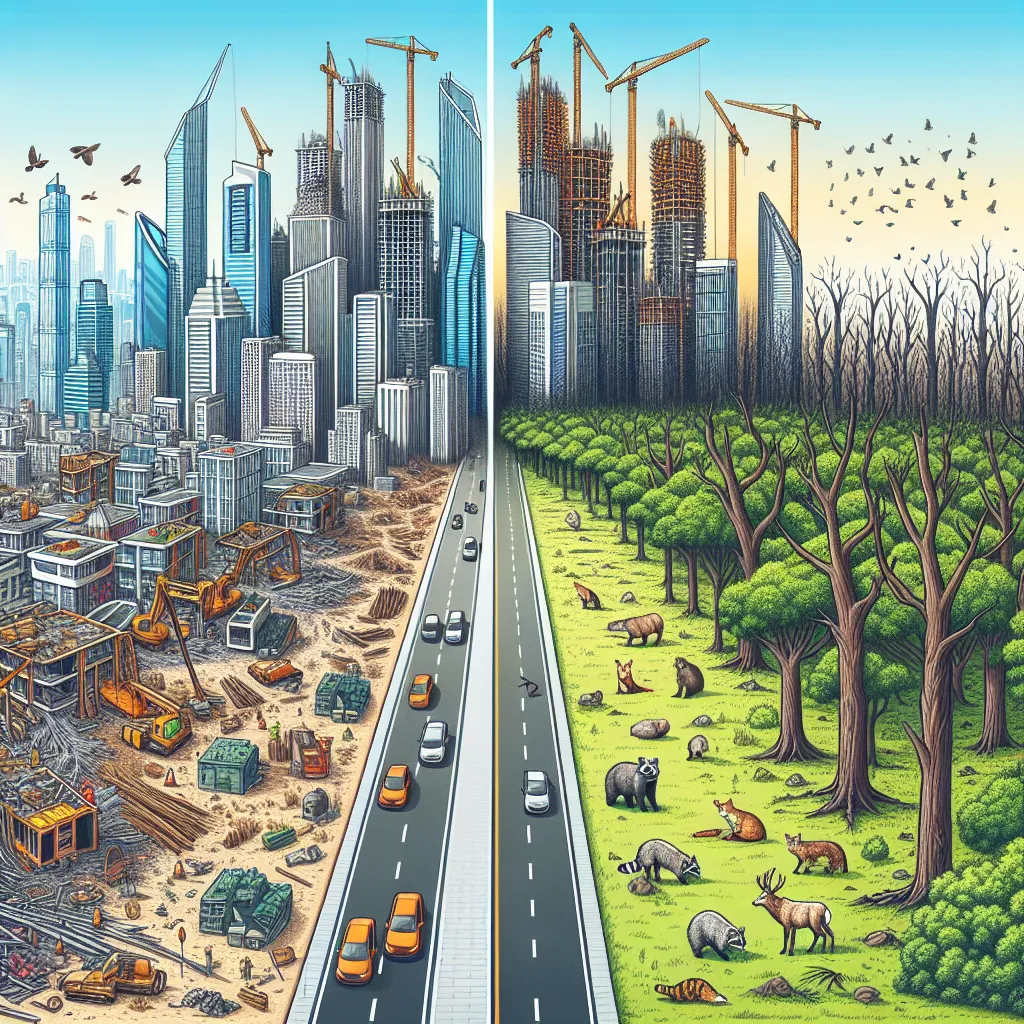Urbanization and its impact on wildlife is a topic that has gained significant attention in recent IELTS exams. This theme falls under the broader category of environmental issues, which has been a recurring subject in IELTS Writing Task 2. Based on analysis of past exam patterns and current global trends, it’s highly likely that this topic will continue to appear in future tests. Let’s explore a sample question that closely resembles those seen in actual IELTS exams:
As cities continue to grow, the natural habitats of animals are being destroyed. What are the causes of this? What can be done to solve this problem?
Analyzing the Question
This question is a classic example of a problem-solution essay. It can be broken down into two main parts:
- Causes of habitat destruction due to urban growth
- Potential solutions to this problem
The question requires you to discuss both aspects thoroughly, providing a balanced view of the issue.
Sample Essay
Here’s a model essay that addresses the question:
The rapid expansion of urban areas has led to a significant reduction in natural habitats for wildlife. This essay will explore the primary reasons behind this phenomenon and suggest potential measures to mitigate its impact.
The main cause of habitat destruction is the increasing demand for land to accommodate growing urban populations. As cities expand, forests, wetlands, and grasslands are cleared to make way for housing, industrial zones, and infrastructure. This urban sprawl not only directly destroys habitats but also fragments remaining natural areas, making it difficult for wildlife to thrive. Additionally, the extraction of resources to fuel urban development, such as mining and logging, further contributes to habitat loss.
Another factor is the lack of effective urban planning and environmental regulations. Many cities grow haphazardly without considering the long-term environmental consequences. Weak enforcement of existing environmental protection laws also allows for unchecked development in ecologically sensitive areas.
To address this issue, several measures can be implemented. Firstly, cities should adopt smart growth strategies that prioritize high-density development and the preservation of green spaces. This approach can reduce the need for outward expansion and maintain habitats within and around urban areas. Secondly, stricter environmental regulations and their rigorous enforcement are crucial to protect critical habitats from development.
Furthermore, the creation of wildlife corridors can help connect fragmented habitats, allowing animals to move freely between protected areas. This can be achieved through the establishment of green belts, urban forests, and networks of parks. Restoration projects aimed at rehabilitating degraded habitats within and around cities can also play a vital role in supporting urban wildlife.
Public awareness and education are equally important. By fostering a deeper understanding of the importance of biodiversity and the impact of urbanization on wildlife, citizens can be encouraged to support conservation efforts and make more environmentally conscious decisions.
In conclusion, while the expansion of cities poses a significant threat to wildlife habitats, there are various strategies that can help mitigate this problem. By combining smart urban planning, stronger environmental protections, habitat restoration, and public engagement, it is possible to create cities that coexist harmoniously with nature.
(Word count: 343)

Writing Tips
When tackling this type of essay, keep the following points in mind:
- Structure: Ensure a clear introduction, separate paragraphs for causes and solutions, and a concise conclusion.
- Balance: Devote roughly equal attention to both causes and solutions.
- Specificity: Provide specific examples and details to support your points.
- Cohesion: Use appropriate linking words to connect ideas smoothly.
- Vocabulary: Employ a range of relevant vocabulary related to urbanization and wildlife.
Key Vocabulary
Here are some important terms to remember for this topic:
- Urban sprawl (noun) /ˈɜːbən sprɔːl/ – The uncontrolled expansion of urban areas.
- Habitat fragmentation (noun) /ˈhæbɪtæt ˌfræɡmənˈteɪʃən/ – The process of dividing larger habitats into smaller, isolated patches.
- Biodiversity (noun) /ˌbaɪəʊdaɪˈvɜːsəti/ – The variety of plant and animal life in a particular habitat.
- Ecosystem (noun) /ˈiːkəʊˌsɪstəm/ – A biological community of interacting organisms and their physical environment.
- Conservation (noun) /ˌkɒnsəˈveɪʃən/ – The protection of plants, animals, and natural areas.
- Mitigation (noun) /ˌmɪtɪˈɡeɪʃən/ – The action of reducing the severity or seriousness of something.
- Sustainable development (noun) /səˌsteɪnəbl dɪˈveləpmənt/ – Development that meets present needs without compromising future generations.
- Wildlife corridor (noun) /ˈwaɪldlaɪf ˈkɒrɪdɔː/ – Areas of habitat connecting wildlife populations separated by human activities.
Conclusion
The topic of urbanization’s effects on wildlife is likely to remain relevant in IELTS Writing Task 2. To prepare effectively, practice writing essays on related themes such as:
- The balance between urban development and environmental protection
- The role of technology in wildlife conservation in urban areas
- The importance of green spaces in cities for both humans and wildlife
- The economic implications of wildlife conservation in urban planning
By mastering this topic, you’ll be well-prepared to tackle a range of environmental and urban development questions in your IELTS exam.